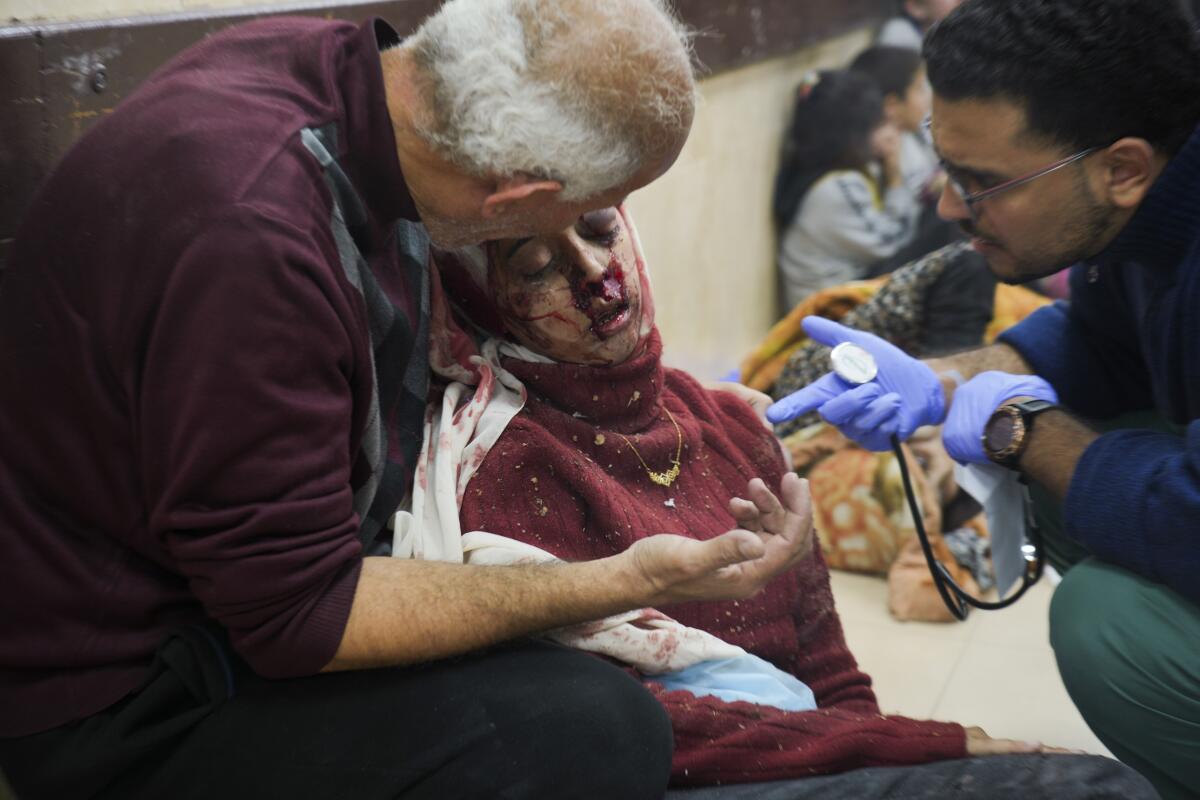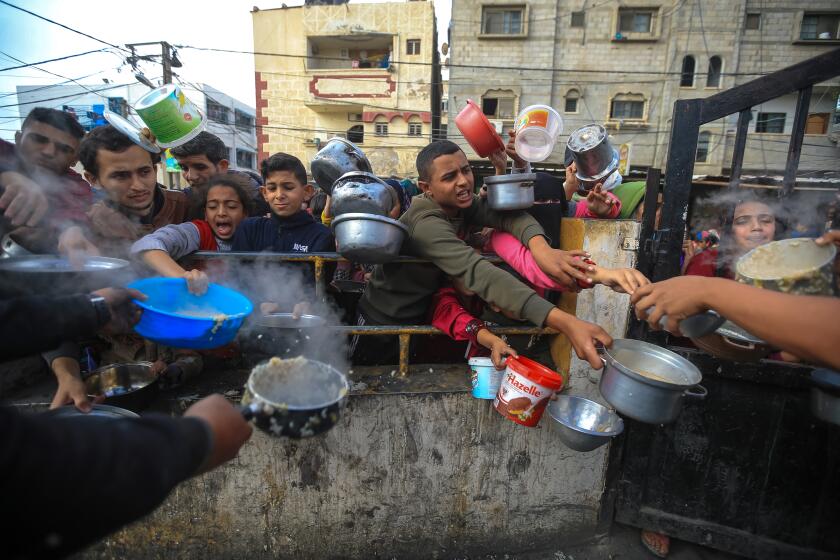Israel is pulling thousands of troops from Gaza as combat focuses on enclave’s main southern city

- Share via
TEL AVIV — The Israeli military confirmed Monday that it was pulling thousands of troops out of the Gaza Strip, a step that could clear the way for a new long-term phase of lower-intensity fighting against the Hamas militant group.
The confirmation of the planned troop drawdown came the same day that Israel’s Supreme Court struck down a key component of Prime Minister Benjamin Netanyahu’s contentious judicial overhaul plan.
While the plan is not directly connected to the war effort, it was the source of deep divisions in Israel and had threatened the military’s readiness before the Oct. 7 Hamas attack that triggered the ongoing war.
Politicians warned against reigniting those divisions and harming the national unity that has prevailed throughout the Israel-Hamas war.
Netanyahu has vowed to press ahead with the military offensive until Hamas is crushed and the more than 100 hostages still held by the militant group in Gaza are freed.
The Biden administration views the two-state solution — an independent Palestinian state alongside Israel — as the only way to stop generations of violence.
But Israel has come under growing international pressure to scale back an offensive that has led to the deaths of nearly 22,000 Palestinians. U.S. Secretary of State Antony J. Blinken, who has repeatedly urged Israel to do more to protect Palestinian civilians, is expected in the region next week.
In its announcement, the army said that five brigades, or several thousand troops, would be taken out of Gaza in the coming weeks. Some will return to bases for further training or rest, while many older reservists will go home. The war has taken a toll on the economy by preventing reservists from going to their jobs, running their businesses or returning to university studies.
The army’s chief spokesman, Rear Adm. Daniel Hagari, did not say whether the withdrawal of some troops reflected a new phase of the war.
“The objectives of the war require prolonged fighting, and we are preparing accordingly,” he told reporters late Sunday.
The move is in line with the plans that Israeli leaders have outlined for a low-intensity campaign, expected to last for much of the year, that focuses on remaining Hamas strongholds.
Israel has said it is close to operational control over most of northern Gaza, reducing the need for forces there. Yet fierce fighting has continued in other areas of the Palestinian territory, especially the south, where many of Hamas’ forces remain intact and where most of Gaza’s 2.3 million people have fled.
With tensions remaining high across the region, the U.S. announced Monday that it would be sending an aircraft carrier strike group home and replacing it with an amphibious assault ship and accompanying warships.
Israel has vowed to destroy Hamas’ military and governing capabilities in its war. The militant group’s October attack on southern Israel killed 1,200 people, and roughly 240 people were taken hostage.
Israel responded with an air, ground and sea offensive that has killed more than 21,900 people in Gaza, two-thirds of them women and children, according to the Hamas-run Health Ministry in Gaza, which does not differentiate between civilians and combatants in its count. The Israeli military says 173 soldiers have died since it launched its ground operation.
Israel also says more than 8,000 militants have been killed, without providing evidence. It blames Hamas for the high civilian death toll, saying the militants embed within residential areas, including schools and hospitals.
The war has displaced some 85% of Gaza’s 2.3 million residents, sending swells of people seeking shelter in Israeli-designated safe areas that the military has nevertheless bombed. Palestinians are left with a sense that nowhere is safe .
U.N. and other agencies sound alarm over ‘acute food insecurity’ in Gaza. One in 4 Palestinian households is facing extreme hunger.
In Khan Yunis, a city in southern Gaza that Israel says is a key Hamas stronghold, residents reported airstrikes and shelling in the west and center of the city. Combat was also reported in urban refugee camps in central Gaza, where Israel expanded its offensive last week.
An Associated Press reporter saw at least 17 bodies, including those of four children, at a hospital in the central town of Deir al Balah after a missile struck a house.
“It’s our routine: bombings, massacres and martyrs,” said Saeed Moustafa, a Palestinian from the Nuseirat camp.
Gaza’s Health Ministry said Monday that 156 people had been killed in the past day. The Israeli military said an airstrike killed Adel Mismah, a regional commander of Hamas’ elite Nukhba forces, in Deir al Balah.
In Israel, Kibbutz Beeri, one of the communities hit by Hamas on Oct. 7, announced Monday that Ilan Weiss, who was thought to have been kidnapped, is now believed to be dead. His wife, Shiri, 53, and daughter Noga, 18, were held captive in Gaza and released Nov. 25 during a weeklong cease-fire.
For a Thai farmworker taken hostage by Hamas militants Oct. 7, memories of Israel and Gaza are of love, grief and heartbreak for those she left behind.
The fighting in Gaza has threatened to spread across the region.
Israel has engaged in nearly daily battles with Hezbollah militants in Lebanon, to Israel’s north, and struck Iranian-linked targets in neighboring Syria as well. Meanwhile, Iranian-backed Houthi rebels in Yemen have fired long-range missiles at Israel and attacked civilian cargo ships in the Red Sea, disrupting the global shipping trade.
The United States has sent warships to the Mediterranean and Red seas, providing protection for Israel and underscoring concerns the fighting could widen.
On Monday, the U.S. Navy announced that after months of extra duty at sea, the USS Gerald R. Ford aircraft carrier strike group will be heading home. The Ford will be replaced by the amphibious assault ship the USS Bataan and its accompanying warships, the USS Mesa Verde and the USS Carter Hall. The three vessels had been in the Red Sea.
The Ford was sent to the eastern Mediterranean to be within striking distance of Israel since the day after Hamas’ Oct. 7 attacks. Its accompanying warships had sailed into the Red Sea, where they repeatedly intercepted incoming ballistic missiles and attack drones fired from Houthi-controlled Yemen.
The Ford and the aircraft carrier USS Dwight D. Eisenhower have been part of a two-carrier presence bracketing the Israel-Hamas war. The Eisenhower has recently patrolled near the Gulf of Aden, at the mouth of the Red Sea waterway, where many commercial vessels have come under attack in recent weeks.
Jobain reported from Rafah, Gaza Strip, and Magdy from Cairo.
More to Read
Sign up for Essential California
The most important California stories and recommendations in your inbox every morning.
You may occasionally receive promotional content from the Los Angeles Times.













